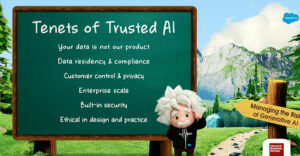There’s a virtuous circle pattern being drawn in society by CRM and it’s been ongoing for many years already.
First, cloud-based CRM democratized business information, then it erased the distance between customers and vendors. Now it is poised to expand into other areas with similar democratizing opportunities. I am speaking about how we work — at least those of us in the knowledge economy — but there’s a good chance that CRM’s reach will also influence the economy of essential workers too.
I can reference two recent articles that help make the point.
First, in the Atlantic, “Kill the 5-Day Work Week” by Joe Pinsker. As you might deduce from the title, the piece provides solid evidence that some leading companies reduced employee hours to a four-day schedule during the pandemic. The result? Little downside and lots of positives like increased productivity.
The second followed closely on the heels of the Atlantic piece. In the New York Times, opinion writer and social scientist David Brooks wrote “The American Renaissance Has Begun” in which he argues that the pandemic has caused many of us to rethink our relationship with work and how we might rebalance it.
Both articles suggest that more of us need more down time to process life and to address those personal moments that won’t ever come again. It’s not that there’s one specific thing these articles address like seeing more of your kids or wasting less time parked on the interstate during rush hour.
Birth of Automated Processes
What both theorize is that we are at a tipping point made possible in the end by productivity gains made since the 1990s (thirty years!), because that’s when we began automating so many business processes, beginning with installing corporate networks and PCs occupying valuable desk space.
That’s roughly the timeline of CRM and slightly less than the timeline for the back office. By the mid-1990s companies like Siebel were making inroads with the elements of CRM such as SFA.
I was a salesguy in those years and I can tell you that there was no greater advancement in helping me do my job than SFA.
For the first time, with SFA you could remember essential elements of many deals without resorting to spreadsheets and paper files that were nearly impossible to manage.
SFA had its detractors for sure, especially those who said that entering data was keeping them from selling. Those people dug in and made the rollout of SFA and CRM generally harder.
But I saw things differently.
If you know accounting, you know how important it is to journal transactions to memorialize them. You can deal with applying a journal later, but you need to capture the raw data. SFA is a journal and the work involved entering data into SFA or CRM prevents a good deal of wasted time and effort later.
Last month I was researching the rollout of CRM at a company in the Toronto area and one of the things that struck me was their matter-of-fact admission that they lost five salespeople out of about 150 during the implementation. While the company was sad to see those people go, they had a policy of 100 percent adoption and were not going to let anything stand in the way.
So, back to the American Renaissance.
The technology innovations of the last three decades have boosted productivity to the point that we can get a week’s worth of work done in 20 percent less time. Companies interviewed in the Atlantic article say productivity is up because employees are happier, and every team member is working for the weekend — in a good way.
But the Renaissance that Brooks describes will depend on even further advances. He rightly notes that the pandemic year of 2020 was the best for entrepreneurship since the 1980s.
Managing Flexible Work Patterns
Now though, today’s entrepreneurs are winging it (as expected) when it comes to organizing work. They’re used to working from home and meeting on Zoom or Google or Webex or whatever. But they have a lot of balls in the air when it comes to employees working from home, on all kinds of devices and at different hours and days of the week. They need help.
Not to worry. If there isn’t an app for that (doubtful), there will be. Early contenders include Salesforce, Oracle, and Zoho just to pick some, though you can also include Microsoft and SAP.
Each has a platform capable of supporting novel development, interesting apps, analytics to grind data into information, and process-building products that enable us to build, change, and maintain business processes in the cloud thus supporting flexible work patterns.
Those tools and the early apps already available like Work.com represent the technology that will make the four-day work week a no-brainer. If we can achieve that, and I think it’s a good bet we can, avoiding the commute 20 percent of the time is just one of the things we’re likely to see.
I think Brooks is right, there is an American Renaissance taking shape. No doubt there are forces that will align against it, but one thing I’ve learned following technology for all these decades is that when a trend this big starts at the grassroots it’s best to join early or get out of the way.




























































